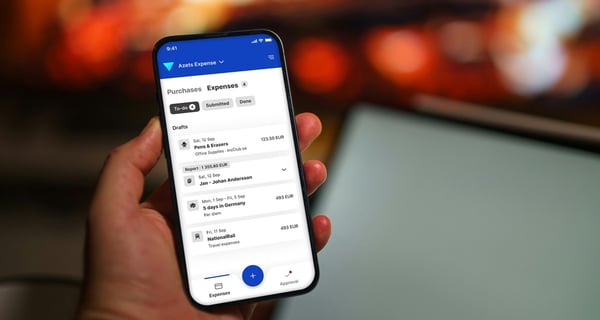

Remote working became the norm for most office workers in 2020. All of a sudden vast numbers of organisations found themselves having to coordinate a paradigm shift overnight simply to stay afloat.
But despite initial concerns, for the most part it actually worked. The great unplanned digital experiment demonstrated that not only could remote working be a viable option, it could in fact be a preferred long-term solution.
However, such change had – and continues to have – a profound effect on the way we do business: something strongly reflected in employee expenses. Not only have the expenses that staff are entitled to changed, but also the normal ways in which they submit expense claims – and provide proof – has changed too.
While it’s easy to dismiss the fact lockdowns and travel restrictions have led to fewer expenses, what many fail to realise is the impact these new ways of working are having on both employees and payroll, finance, and accounting teams.
So let’s take a closer look at how expense management has changed – and continues to change – and how business leaders can address these challenges with an eye on the future.
Shifting Trends in Expense Management
As you might expect, the shift in the way we work has altered the types of expenses being claimed.
Broadly speaking, fewer in-person interactions have reduced the number of hospitality and entertainment (dinner, drinks etc.) expense claims. By contrast, many companies have seen a rise in home office equipment expenses: IT hardware as well as chairs and desks.
However one expense that many companies have now that didn’t exist outside of the healthcare sector in 2019, is personal protective equipment.
As the response to the pandemic has evolved, many companies now operate rotas within their offices so staff come in as smaller groups for a couple of days a week. To help support this, many businesses reimburse staff for things like face masks and hand sanitiser that they use during this time on site.
But the cost of doing so is by no means insignificant. According to the UK’s National Audit Office almost £12.5bn was spent on PPE between February and July 2020. During the same period in 2019, this was just £28.9m.
Although for many companies, food expenditure dropped in 2020, for those with policies covering employee meals over the certain hours worked – or even those who normally subsidise food through canteens – have seen jumps in meal expenses.
Employees now want to get the most out of working from home and are using food delivery services – like UberEats or Deliveroo – more frequently and claiming the expenses.
How Our Own Stats Stack Up
Looking at our own expense data, it’s clear that we have seen a number of big changes in the volume of expenses from the typical categories.
For instance, in 2019, hospitality and entertainment expenses accounted for 2.52% of all expenses made on our platform, compared to 1.03% in 2020.
That’s a shift of 59% – which makes sense when you consider how typical client engagement takes place – often over drinks, dinner, or events. And since no-one’s really travelling, we simply aren’t needing to reimburse people for the cost.
However, although we aren’t conducting more ‘social’ visits, mileage expense claims have risen by 24% between 2019 (6.99%) and 2020 (8.67%). This may seem odd, but for employees and workers that must commute to an office or worksite, the car has become the preferred method of travel – as people aim to avoid public transport altogether.
2020 Expenses Breakdown
| Receipts (expenses) | 77,05 % |
| Mileage | 8,67 % |
| Travel Allowance | 2,14 % |
| Lunch | 9,12 % |
| Dinner | 1,03 % |
| Refreshments | 1,38 % |
| Other | 0,59 % |
What Can Employees Expense & Not Expense?
In ‘normal’ working conditions there are typically different expense requirements between departments – and also between employees’ different levels of seniority.
For example, it’s far more common for senior managers to incur more expenses in a typical working environment. After all, they are more likely to be travelling to see clients, dining with them, as well as attending trade shows or seminars.
The average employee whose work is office based and not client facing is unlikely to incur as many food or mileage expenses during their working day.
Remote working has changed all this however. Essentially all employees find themselves in the same boat – separated from both colleagues and customers.
But this doesn’t mean that they aren’t entitled to be reimbursed for items that they pay for out of their own money – as long as it’s for business use. For example, it may be that a company has in a policy where small pieces of IT equipment – like webcams – can be reimbursed to the employee in light of them needing to be able to attend work meetings online.
Rather than dealing in the procurement team, under such circumstances, staff are better placed to source these items more quickly – and have them delivered directly to their homes.
However, it is crucial that your employees know what is considered an expense and also give your accounts team the information to easily assess any expenses which are claimed for.
Determining what is and isn’t acceptable often comes down to whether a specific item is deemed tax deductible – and how much relief can be claimed – which can vary between nations.
This is why having an expenses policy can make such a big difference. All this involves creating a central document that everyone has access to – showing the basic rates of compensation as well as the spending limits on any particular item.
Distributing this list on your communication platform of choice, Slack or Teams for instance, ensures everyone is notified about the policy in place.
In providing everyone with clear examples of what is considered an expense, you reduce the chance of a member of staff being left out-of-pocket having not been aware of the terms of reimbursement.
It also makes your accounts team’s jobs much easier as they should only have to process genuine expenses as well as have easily understood terms of sign off and repayment.
How Can Accounting & Payroll Deal With These Challenges?
In addition to scrambling to catch up with remote working and adjust to the shifts in employee requirements due to the pandemic, many businesses are also taking the opportunity to digitise their manual processes. But getting payroll teams and the company as a whole onboard with changes in expenses can be a real challenge.
That said, there are some great ways to help staff going forward and this stems from putting effective processes and up-to-date tools in place.
Many businesses have always worked through simple, manual, paper-based processes – i.e. filling in an expenses form, having it signed by a manager, passing it to accounts, and then waiting for it to appear in your bank or via your next payslip. This has been the tried and tested method for as long as… forever.
However, a new set of digital tools can help streamline and automate these processes. Consistency and ease of use are key. You need to ensure that any tools put in place can be accessed by everyone – and that expense claims can still be scrutinised and signed off in the same way as the manual system.
To begin, teams should install a central point that all expenses can be uploaded to – along with proof attached to them. The digitisation of the traditional approach has a number of advantages. Perhaps most importantly, it is far easier to store the proof of receipts. Users simply take photographs of them and upload them alongside their expense claim.
This cuts down on receipts being lost by the employee or in the mail – especially at a time when everyone is working remotely and postal services around the world are struggling to literally deliver..
A further benefit is that some expense tracking solutions, like the ones built on our platform, easily integrate with existing accounting and payroll platforms. Having this feature cuts down a huge amount of the manual work of transferring information from the expense claim into your accounting software. Because of this removal of manual entry, it also cuts down on the risk of input error by the user.
Traceability is another key component of an effective expense management system. Not only for the parity of your accounts, but also for staff’s peace of mind. Your employees will feel a lot more confident about submitting expense claims if they know that they can trace the progress of their claim.
Not only will the claimant be more onboard with the system, but the staff tasked with either signing off the expense or processing it will be able to prove they have actioned items in line with a business’ particular rules.
So long as you digitise your expense practices, ensuring that they are supported by good training for all employees, accounting teams will be able to cut down on the time taken to process expenses, reduce input error, and aid traceability.
Although trends in expenses have shifted dramatically in the past year, historically employee allowances have improved over time as companies seek better working conditions for their staff.
In embracing the idea that these shifts will continue and could, as we have seen from 2020, shift dramatically in a short space of time, we need to give ourselves the best opportunity to succeed.
Understand that if you put good practices in place, with clear guidelines for your staff, and couple this with effective digital platforms, you’ll be successful in managing your company’s business expenses no matter where your teams are working.



